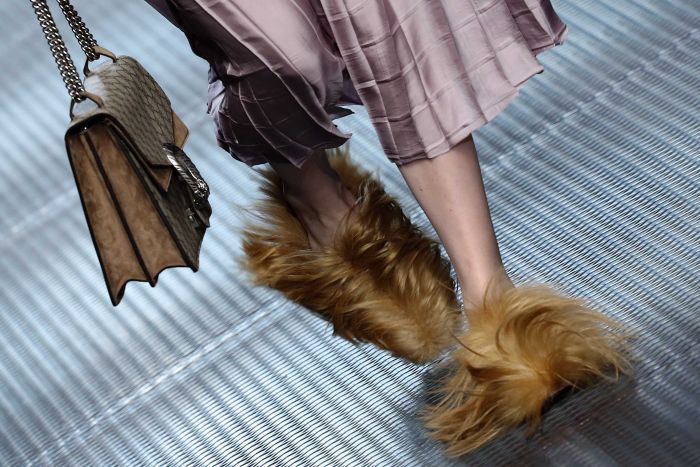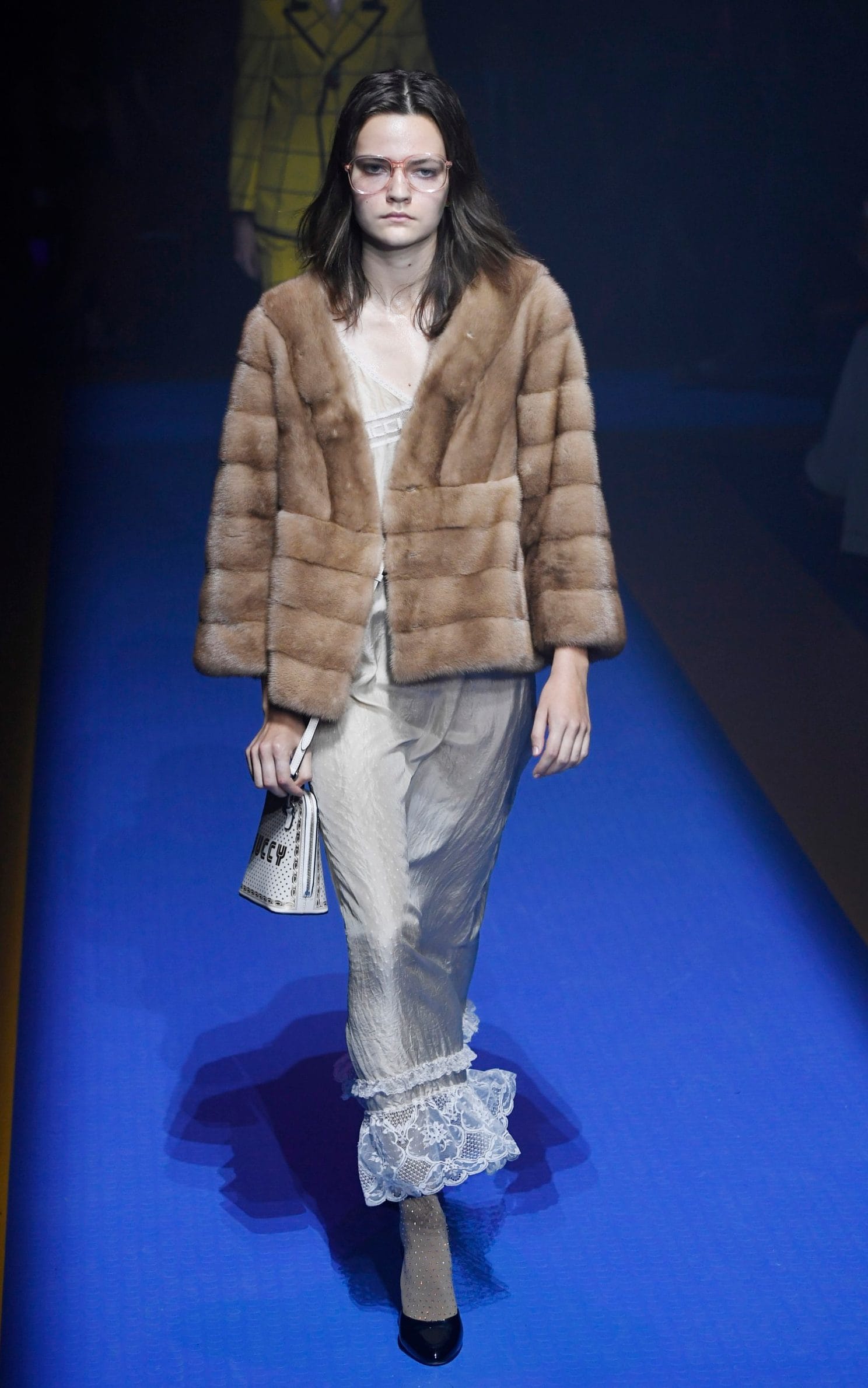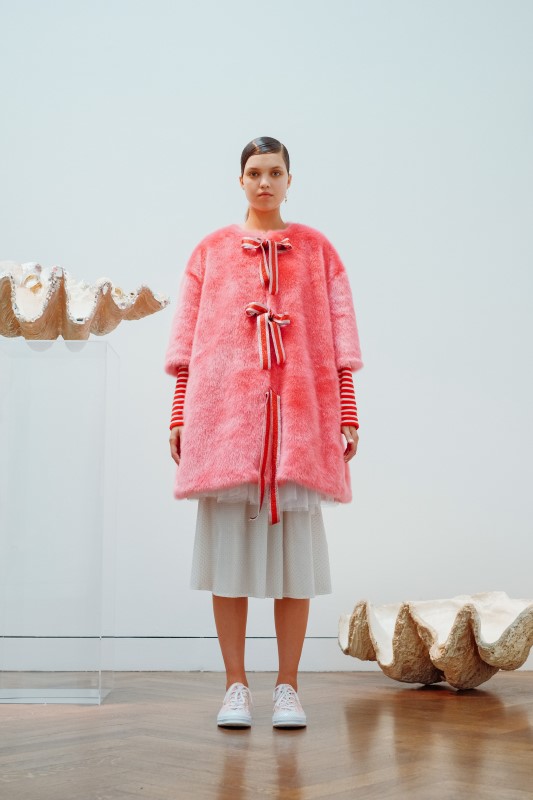Last week witnessed a watershed moment for fashion, as Italian powerhouse Gucci announced their ban on fur. Amongst rapidly rising fur sales, is this an equally defining moment for the fur industry?

We are all mostly au fait with fashion’s ever-changing nature and the pace at which it revolves. But anyone who saw the catwalk images of Gucci’s SS18 collection, shown at Milan fashion week just last month, would never have guessed that mere weeks later the brand would announce a ban on fur.
Walking Gucci’s runway was a full mink coat, fur-trimmed collars and wrists and an admittedly show-stopping glittering red and white heart-appliqued jacket with white yeti fur sleeves. But last week in London, Gucci’s President and CEO Marco Bizzari announced that, starting from the SS18 collection’s arrival in shops, Gucci would join the ranks of fur-free brands, eliminating the use of all fur from future collections. Bizzari added that Gucci will join the Fur Free Alliance, auction off the remainder of its fur items and donate the proceeds to Italian animal rights charity LAV and the international animal rights organization the Humane Society.

‘I don’t think it’s still modern,’ Bizzarri told BoF ahead of a speech in London outlining the move. Despite side-stepping the ethical quandary fur presents, the CEO’s reasoning for Gucci’s move away from fur is still a truly defining moment for the fashion industry. Both because Gucci is one of the most storied fashion houses on the globe and because it has its origins in Italy, where fur is everywhere and in abundance – even well into Spring. Bizzarri has rendered fur instantly and devastatingly uncool. And of course, cool matters in fashion, it matters very much.
Lending heft to the growing chorus of high fashion labels going fur-free has, of course, come to the delight of animal cruelty organisations including PETA.
Ingrid Newkirk, founder of PETA said of Gucci’s news:
“After more than 20 years of PETA protests against Gucci’s kangaroo-fur loafers and seal-fur boots, Gucci has finally pledged to join Armani, Ralph Lauren, and Stella McCartney in the ranks of fur-free fashion houses. The writing was on the wall: Today’s shoppers don’t want to wear the skins of animals who were caged, then electrocuted or bludgeoned to death. Until all animal skins and coats are finally off the racks of clothing stores worldwide, PETA will keep up the pressure on the clothing and fashion industry.”
Simone Pavesi, the manager of animal-free fashion at Italian campaign group LAV, joined the throng of campaigners and activists to congratulate the Italian Megabrand. Gucci’s decision will “radically change the future of fashion,” he said. “As fashion becomes more and more ethical, supply chains that revolve around animals will be a thing of the past.”
Of course, Gucci isn’t the first brand to turn its back on fur-made clothing and accessories. The impassioned fur debate has raged for some time, and not on deaf ears either, it seems. Gucci is merely an addition to the story; offering fur and being a major luxury player are no longer mutually exclusive qualities. Stella McCartney has long spoken out about the unnecessary and cruel use of animal skins, excluding both fur and leather in her collections, yet she remains a key fixture on the Paris Fashion Week schedule. Many department stores, including David Jones and Myer in Australia and Selfridges in London, no longer sell fur products. Last year, Italian label Giorgio Armani joined Ralph Lauren and Tommy Hilfiger in committing to stop using fur, while in June this year, Yoox Net-a-Porter, one of the world’s leading luxury online retailers, stopped selling fur. That action came after a survey of 25,000 clients revealed that more than half of them supported the move. And Calvin Klein took the plunge way back in 1994.
Armani cited the progression of fabric technology, which makes redundant any justification for animal cruelty, when announcing they would be dropping fur last year. Modern technology has become so sophisticated that the warmth and luxury of fur can easily be achieved with the faux kind. Hannah Weiland, designer and founder of London-based cult-label Shrimps is at the forefront of the movement to switch to amazingly soft and luxurious faux fur.

Weiland joined forces with seven other hot names in fashion: Marta Jakubowski, Renli Su, Faustine Steinmetz, JH Zane, Felder Felder, Molly Goddard, and Vika Gazinskaya. The conglomerate wrote to students at London design college Central Saint Martins urging students not to accept bribes from the fur industry, which often offers students and up-and-coming designers financial incentives to include fur and animal skins in their collections.
They wrote:
“In order to be a success in the fashion world, you don’t need to contribute to the barbaric treatment of animals practised by the fur industry. Humane fabrics have never been in more demand, and the growing number of fur-free designs on international catwalks is a clear indication that you can be daring as well as innovative and rule the runways without harming animals.”
Now that a company as seemingly untouchable as Gucci has made the move, can we expect to see a knock-on effect? Last week’s decision is part of an ongoing focus by Kering – the group which owns Gucci as well as Yves Saint Laurent, Alexander McQueen and Bottega Veneta – to become more ‘socially responsible.’ ‘We strive to do better for the environment and animals,’ stated Bizzari during the 2017 Kering Talk at The London College of Fashion. It seems likely then, that some of Kering’s other names won’t be far behind Gucci’s move.
Yet with a global fur trade worth more than US$40 billion (AUS$50.56 billion), we would have to see a lot of big-name labels following suit. In China, Japan and South Korea fur sales tripled in the 10 years leading up to 2012. According to the International Fur Federation, “there are newer markets” popping up in India and Iran “with massive potential where we will be working hard to drive further interest.” The new Autumn/Winter ’17 collections that have just arrived at luxury online retailer Matches Fashion have loads of furs, J.W. Anderson has Argentinian fox, Vetements is pushing mink. Prada’s wool coats have fox fur cuffs.
Mark Oaten, CEO of the International Fur Federation, says he is “confident” in the longevity of the fur market. “Today’s decision from Gucci is surprising because we’ve seen an upward trajectory in fur sales,” he told The Telegraph, highlighting Korea, America’s East Coast and London as particular hotspots for fur sales. “I also find the environmental argument bizarre because whatever you think about fur, you can’t deny that it is one of the most natural, biodegradable materials there is.”
The emotive fur debate came to somewhat of a climax last month during London’s fashion week. The activist group Surge caused chaos at some shows including Burberry, Versus Versace and Gareth Pugh, among others that were targeted. Their presence was to pressure the British Fashion Council into banning the use of fur on catwalks. “We wanted to make a bold statement at targeted shows where we knew the designers had used fur,” said Ed Winters, the group’s co-director. No doubt the divisive topic will continue to be debated in the coming months.

So is Bizarri’s latest move really the fur industry’s kiss of death? It’s certainly not going to make an immediate impact in the multi-billion dollar industry, but could it be the start of a slow trajectory towards more cruelty-free clothing across the board? Absolutely. After all, no fashion label worth its salt would consider being a part of something that is ‘no longer modern.’







